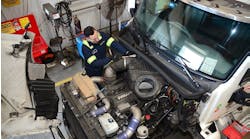When I reviewed options for different technical schools and professional truck driver programs in the area, one aspect that stood out with Waukesha County Technical College's program was the focus on learning how to shift properly in a world where automated manual transmissions are becoming more commonplace.
Sure, you can go to any "truck driving school" and learn how to drive a Class 8 tractor-trailer. But, WCTC really put an emphasis on making sure you understand the fundamentals behind why and how to shift the transmission.
The last few days have been an overload of information on reviewing the basics of how an 8-speed and a 10-speed transmission are mapped, understanding the rpm range for upshifting and downshifting and the importance of double clutching.
As we're starting out, we begin in first gear. (This is for training purposes - for the real world, we'd likely start out in second or third). Here's a basic rundown of upshifting: Once you start accelerating and reach about 1,500 rpm, take your right foot off the accelerator and immediately place your left foot on the clutch. Decompress the clutch pedal until the clutch reaches the friction point to disengage the gear. Move the gear shift lever into neutral, clutch again and shift into the next gear. (What's known as double clutching) This all happens in a matter of seconds. Then it starts again to reach the next gear.
Instead of knowing the specific gear you're in, you understand the layout, or mapping of the gears. As a general rule, if you're shifter is down, it will always be heading up for the next shift (or, vise versa when downshifting).
The instructors stress the importance of understanding the process of shifting. A driver might be in one dedicated truck and finesse that shifter into place with some time. But does he or she really understand when and how to shift? Apparently, it's not so common for driver.
For the next several days, we'll be learning on virtual machines that allow us to test out upshifting and downshifting (without destroying any clutch brakes or, worse, dropping any transmissions). But come Monday, we're heading out onto the range to get in the cab and try out the real deal. Stay tuned!
WCTC also hosted a fantastic meet-and-greet session for recently graduated and current students in the professional truck driving and diesel technician programs. There I talked with a number of fleets who confirmed they're slowly adopting automated manual transmissions, but still have a number of manuals in the fleet. One fleet owner I talked with even said, while they have nearly all AMTs in the fleet, he refuses to hire someone who can't operate a manual transmission.
...
In the Driver’s Seat is a blog series from Fleet Maintenance editor-in-chief Erica Schueller. The series covers the process of attending a formalized technical training professional truck driving program in order to obtain a Class commercial vehicle driver’s license.




